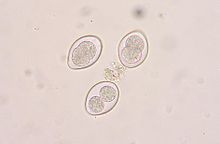| Coccidia | |
|---|---|

| |
| Coccidia oocysts in a fecal flotation from a cat. The cat was underweight and had diarrhea, showing signs of coccidiosis. | |
| Scientific classification | |
| Domain: | Eukaryota |
| Clade: | Diaphoretickes |
| Clade: | SAR |
| Clade: | Alveolata |
| Phylum: | Apicomplexa |
| Class: | Conoidasida |
| Subclass: | Coccidia Leuckart, 1879 |
| Orders | |
| Synonyms | |
| |
Coccidia (Coccidiasina) are a subclass of microscopic, spore-forming, single-celled obligate intracellular parasites belonging to the apicomplexan class Conoidasida.[1] As obligate intracellular parasites, they must live and reproduce within an animal cell. Coccidian parasites infect the intestinal tracts of animals,[2] and are the largest group of apicomplexan protozoa.
Infection with these parasites is known as coccidiosis. Coccidia can infect all mammals, some birds, some fish, some reptiles, and some amphibians. Most species of coccidia are species-specific in their host. An exception is Toxoplasma gondii, which can infect all mammals, although it can only undergo sexual reproduction in cats. Depending on the species of coccidia, infection can cause fever, vomiting, diarrhea, muscle pain, and nervous system effects and changes to behavior, and may lead to death. Healthy adults may recover without medication—but those who are immunocompromised or young almost certainly require medication to prevent death. Humans generally become infected by eating under-cooked meat, but can contract infection with T. gondii by poor hygiene when handling cat waste.
- ^ Brands SJ (2000). "The Taxonomicon & Systema Naturae" (Website database). Taxon: Genus Cryptosporidium. Amsterdam, the Netherlands: Universal Taxonomic Services.
- ^ "Biodiversity explorer: Apicomplexa (apicomplexans, sporozoans)". Iziko Museums of Cape Town. Archived from the original on 2006-09-23. Retrieved 2006-10-13.